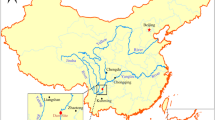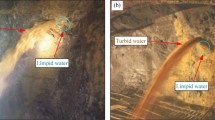Abstract
On condition that the seepage coefficients of sediment and stratum are narrowly or widely different, seepage stratum is homogeneous or layer. The muddy water seepage integral and differential equations based on Darcy’s law are established, and then their difference formula of the differential equations are derived. The method presented was used in the deep recharge test in Shizuishan, where power plant cooling tailing water was used to recharge and mine deep underground water. This is firstly used in China. The law of sediment accumulation on the earth surface, and the rule of infiltration capacity changing with time are studied. The pattern of water table changing with time affected by the recharge irrigation is predicted.
Similar content being viewed by others
References
Yuan L J, Li Z Q, Wu S Z, et al. Engineering Seepage Mechanics and Its Application (in Chinese). Beijing: China Building Industry Press, 2001
Malkawi A I H, Al-Sheriadeh M. Evaluation and rehabilition of dam seepage problems. Eng Geol, 2000, 56: 335–345
Bathe K T, Khoshgoftaar M R. Finite element free surface analysis without mesh iteration. Intern J Number Methods Engrg, 1979, 4(1): 13–22
Geo-Slope International Ltd. SEEPW Engineering Book. Version 5, User’s Guide. Calgary: Geo-Slope International Ltd, 2001
Oden J T, Kikuchi N. Recent advances: Theology of variational inequalities with applications to problems of flow through porous media. Intern J Eng Sci, 1980, 18: 173–184
Bruch J C. A survey of free boundary value problems in the theory of fluid flow through porous media: Variation inequality approach. Adv Water Res, 1980, 3: 65–80
Lacy S J, Prevost J H. Flow through porous media: A procedure for locating the free source. Intern J Num Anual Methods Geomesh, 1987, 11: 585–601
Desai C S. Finite element residual schames for unconfined flow. Intern J Numer Methods Engrg, 1976, 10(6): 1415–1418
Cheng C Q, Zhang D, Zheng G S. On colmatage of suspensoid and its influence upon flowing states of suspensions in porous media. Coal Geol Explor (in Chinese), 2001, 29(5): 43–45
Trzaska A. The effect of colmatage on the magnitude of the discharge of flow during bore-hole exploration of water. Archiwwm Gornictwa, 1988, 33(1): 34–38
Zhang L H, Xiong H J, Zhang Q. Analysis of the unsteady permeation process of grout. Chin J Geotechn Eng (in Chinese), 1997, 16(6): 564–570
Shen X Y. Analysis of seepage of the mortar in permeation grouting. J Tongji Univ (in Chinese), 1994, 22(2): 209–214
Zhang J H, Hu Q, Liu Z H. A theoretical model for mud-filtrate invasion in reservoir formations drilling. Acta Petrol Sinica (in Chinese), 1994, 15(4): 73–78
Bear J. Hydraulics of Groundwater. New York: McGraw-Hill, 1979, 89–90
Ames W F. Non-linear Partial Differential Equation in Engineering. New York: Academic Press, 1965, 135–136
Author information
Authors and Affiliations
Corresponding author
Rights and permissions
About this article
Cite this article
Dang, F., Liu, Y., Chen, J. et al. Muddy water seepage theory and its application. SCI CHINA SER E 49, 476–484 (2006). https://doi.org/10.1007/s11431-006-2011-4
Received:
Accepted:
Issue Date:
DOI: https://doi.org/10.1007/s11431-006-2011-4




